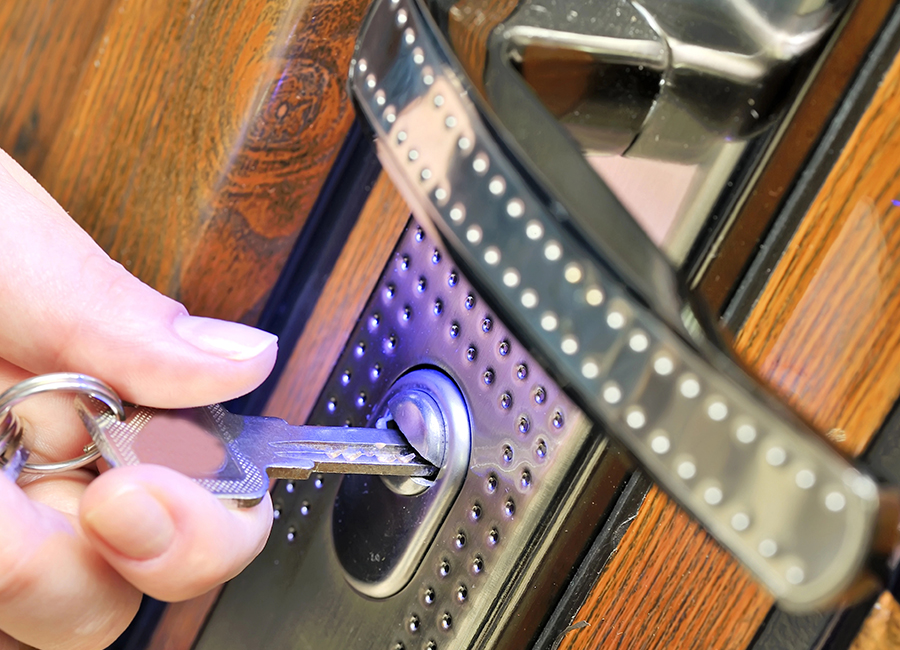Locks do more than just secure doors. They protect homes, workplaces, and possessions from unwanted access. Yet we often forget that locks need care too. Over time, dirt, moisture, and frequent use can wear them down. Regular maintenance helps them last longer and work more smoothly, avoiding sudden malfunctions that may leave you locked out or needing a replacement.
Good maintenance habits also make locks safer. A lock that turns easily, fits snugly, and closes securely provides peace of mind every day. In this post, we’ll go over simple, practical steps to help you maintain your locks, along with a few insights that can prevent early damage or expensive repairs later on.
Keep Locks Clean and Free of Debris
Dust and dirt are common enemies of any lock mechanism. When particles collect inside the keyway, they grind against internal pins and springs, creating friction and uneven wear. Over time, this leads to stiffness and key jamming.
Start by cleaning the exterior with a damp cloth, wiping away dust or buildup. For the interior, use a can of compressed air to blow out debris from the keyhole. Avoid using water or household cleaners, as they may cause rust. A simple cleaning every few months keeps the cylinder free from friction and improves key rotation.
If you notice metal shavings on your key or difficulty inserting it, this could signal damage inside the cylinder. Addressing it early prevents deeper wear and helps extend the lifespan of the entire lock.
Lubricate Locks the Right Way
Proper lubrication is one of the easiest ways to extend a lock’s life. It reduces friction and keeps parts moving smoothly. However, not all lubricants are suitable. Many people reach for oil-based products, but these attract dust and thicken over time. The better choice is a dry graphite or silicone-based lubricant designed for locks.
To apply it, insert the straw into the keyhole, give it a short spray, and turn the key several times to spread the product. If you live in a humid area, repeat this every six months. For dryer regions, once a year is enough.
Also pay attention to the hinges and strike plates, especially on exterior doors. Smooth hardware movement reduces strain on the locking mechanism, which keeps the latch and bolt aligned for longer.
Handle Keys Carefully
Keys are an extension of the lock itself. When they bend, crack, or collect dirt, they transfer that stress to the cylinder. Avoid forcing a key that does not turn smoothly. Instead, remove it, clean it with a mild soap solution, dry it well, and try again.
Never use one key to operate multiple locks unless they are designed for a master key system. Each lock has its own pattern, and using mismatched keys can cause permanent internal damage. Also, avoid hanging heavy keychains, which put unnecessary pressure on the key when it’s inside the lock.
Making spare keys before the original wears out is another smart practice. Worn keys create wear patterns that pass directly onto the pins, shortening the lock’s usable life.
Check Alignment Between Lock and Door
Even a well-maintained lock fails quickly if the door is misaligned. When the latch or bolt does not meet the strike plate properly, friction builds with every turn of the key. This causes the mechanism to grind and eventually deform.
Inspect your doors regularly to ensure smooth closing without resistance. If you notice rubbing, tighten loose hinges or adjust the strike plate screws. In colder months, wooden doors often expand, slightly shifting alignment. A small adjustment at the hinge can prevent the lock from sticking or binding.
If the misalignment continues, it may indicate a deeper structural issue. In that case, professional help from a locksmith in Ottawa ensures proper correction before damage occurs.
Protect Locks From Weather
Exterior locks face constant exposure to the elements. Rain, snow, dust, and temperature changes all affect how well they work. Moisture in particular can lead to corrosion, while freezing conditions can trap condensation inside the mechanism, causing it to jam.
Installing weather-resistant covers helps shield locks from direct exposure. You can also apply a small amount of graphite or silicone lubricant before the start of winter. This creates a protective layer that resists freezing. Avoid spraying de-icing fluids directly into the keyway, as these can strip lubricants and accelerate wear.
For homes in areas with harsh winters or salt exposure, rinse the exterior of locks occasionally to remove salt residue, which corrodes metal faster than moisture alone.
Test Locks Regularly
A quick monthly check helps you catch early signs of trouble. Insert your key, turn it, and pay attention to how it feels. A healthy lock turns smoothly and without delay. If you feel grinding, stiffness, or hear unusual clicks, it might need cleaning or lubrication.
Also test deadbolts and latches. The bolt should extend fully when you turn the key, and retract smoothly. Loose knobs or wobbly cylinders suggest the screws or internal plates have shifted and need tightening.
Routine testing not only maintains function but also prevents emergency repairs. A few minutes of attention each month can save hours of frustration later.
Avoid DIY Fixes When the Lock Jams
It may be tempting to force a jammed lock or insert tools into the keyhole, but this often causes more harm than good. Internal parts like pins and springs are delicate, and applying pressure can bend or break them.
If a lock suddenly stops turning, try gentle cleaning and lubrication first. If it still resists, stop. Continued force may break the key or damage the cylinder completely. In these cases, professional service ensures safe repair without risking further issues.
You can reach out to contact us for trusted help if you ever encounter a lock that stops functioning properly. A qualified technician can often repair or rekey it instead of replacing it entirely, saving both time and money.
Maintain Both Residential and Commercial Locks
Homes and workplaces face different challenges, but the principles of care remain the same. Residential locks need regular attention to prevent key jams and corrosion from everyday use. Interior locks, such as those on bathrooms and bedrooms, can go years without inspection, yet dust buildup still affects them over time.
Commercial locks face heavier traffic and require more frequent maintenance. Office doors, storage rooms, and access control points handle hundreds of turns a day, wearing down pins faster. Regular cleaning, lubrication, and inspection of door closers help extend their lifespan.
If you manage a business or property, scheduling preventive service from a professional helps keep systems secure and operational. For detailed support, visit commercial locksmith Ottawa to learn more about proper maintenance for high-traffic locks.
Recognize When Replacement Is Better
Even with good care, every lock eventually reaches its limit. Signs that it may be time for replacement include keys that no longer fit tightly, bolts that no longer fully extend, or visible rust around the keyhole.
Replacing an old or unreliable lock before it fails is far safer than waiting for it to jam unexpectedly. It also ensures that your security standards remain up to date, especially for exterior or entry doors.
When upgrading, consider modern deadbolts or electronic locks designed to resist weathering and tampering. These newer models often include coatings or internal materials that better handle daily use without losing precision.
Spare Locks and Keys Properly
Many people keep spare locks, padlocks, or extra keys in garages or storage areas where temperature and humidity fluctuate. Over time, this exposure causes premature corrosion. Storing spares in a dry, sealed container inside your home keeps them in good condition for future use.
If you store padlocks outdoors, apply a small coat of weatherproof lubricant before leaving them exposed. Periodically turn the key to ensure the internal parts remain mobile and not seized by rust.
Taking care of even the spares saves you from surprises when you need them most.
Extra Insight: The Role of Keyway Design
One lesser-known factor in lock lifespan is keyway design. Some locks use narrow, intricate keyways to increase security, but they also trap dirt more easily. If you notice your key getting dirty every time you use it, this may be a sign that the design collects debris.
Regular cleaning becomes even more important with these types of locks. A soft brush or compressed air helps clear tight corners where dust hides. While you can’t change the design itself, adjusting your maintenance frequency can significantly extend its life.
FAQ
1. How often should I lubricate my locks?
In most homes, once a year is enough. For exterior or high-traffic locks, every six months keeps them smooth and prevents rust.
2. Can I use WD-40 on locks?
No. It is oil-based and collects dust inside the mechanism. Choose a graphite or silicone spray designed for locks instead.
3. What if my key gets stuck halfway?
Do not force it. Gently wiggle it while applying light pressure. If it still sticks, clean and lubricate the keyhole. If that fails, call a professional to avoid breaking the key.
4. Why does my lock feel rough after winter?
Cold air and condensation can create internal rust or stiffness. Warming the key slightly before use and applying lubricant helps restore movement.
5. How can I tell if my lock needs replacing?
When the key no longer fits tightly, the bolt fails to extend fully, or you notice rust or wobbling in the cylinder, replacement is likely the best option.

